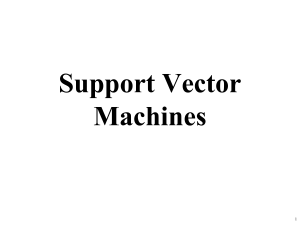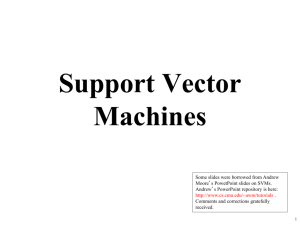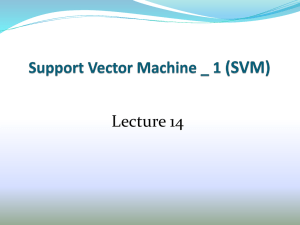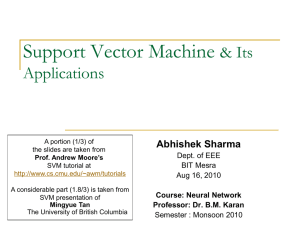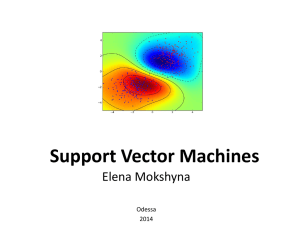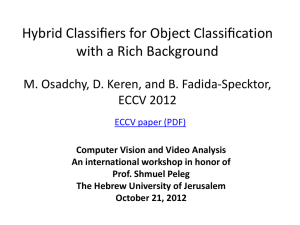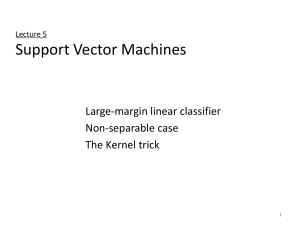Support Vector Machines Tutorial
advertisement
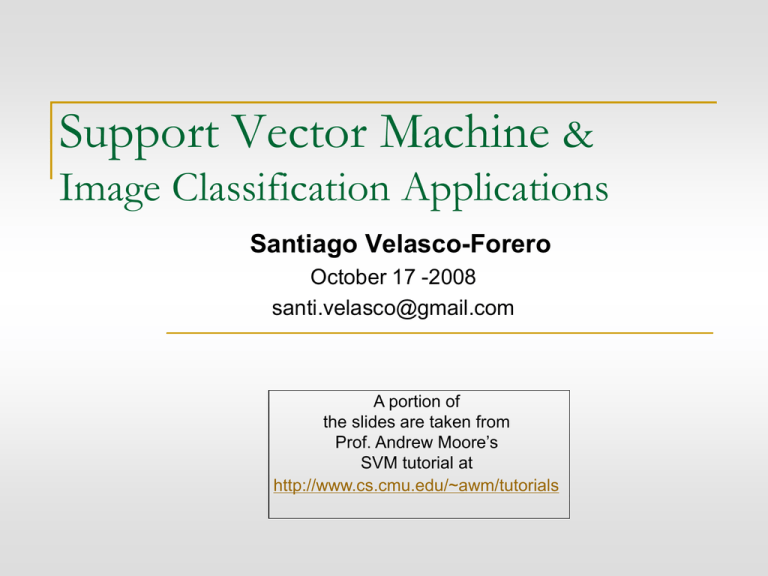
Support Vector Machine &
Image Classification Applications
Santiago Velasco-Forero
October 17 -2008
santi.velasco@gmail.com
A portion of
the slides are taken from
Prof. Andrew Moore’s
SVM tutorial at
http://www.cs.cmu.edu/~awm/tutorials
Overview
Intro. to Support Vector Machines (SVM)
Properties of SVM
Applications
Image Classification
Hyperspectral Image Classification
Matlab Examples
Linear Classifiers
x
denotes +1
w x + b>0
f
yest
f(x,w,b) = sign(w x + b)
denotes -1
How would you
classify this data?
w x + b<0
Linear Classifiers
x
denotes +1
f
yest
f(x,w,b) = sign(w x + b)
denotes -1
How would you
classify this data?
Linear Classifiers
x
denotes +1
f
yest
f(x,w,b) = sign(w x + b)
denotes -1
How would you
classify this data?
Linear Classifiers
x
denotes +1
a
f
yest
f(x,w,b) = sign(w x + b)
denotes -1
Any of these
would be fine..
..but which is
best?
a
Linear Classifiers
x
denotes +1
f
yest
f(x,w,b) = sign(w x + b)
denotes -1
How would you
classify this data?
Misclassified
to +1 class
Classifier Margin
x
denotes +1
denotes -1
a
f
yest
f(x,w,b) = sign(w x + b)
Define the margin
of a linear
classifier as the
width that the
boundary could be
increased by
before hitting a
datapoint.
Maximum Margin
a
x
denotes +1
denotes -1
Support Vectors
are those
datapoints that
the margin
pushes up
against
f
yest
f(x,w,b) = sign(w x + b)
1. Maximizing the margin is good
according to intuition.
The maximum
2. Implies that only support
marginvectors
linear are
important; other training
examples
classifier
is the
are ignorable.
linear classifier
3. Empirically it works
verythe
well.
with
maximum
margin.
Linear SVM
This is the
simplest kind of
SVM (Called an
LSVM)
Linear SVM Mathematically
x+
M=Margin Width
X-
What we know:
w . x+ + b = +1
w . x- + b = -1
w . (x+-x-)= 2
(x x ) w 2
M
w
w
Linear SVM Mathematically
Goal: 1) Correctly classify all training data
wxi b 1 if yi = +1
wxi b 1 if yi = -1
yi (wxi b) 1 for all i 2
M
2) Maximize the Margin
1 t w
ww
same as minimize
2
We can formulate a Quadratic Optimization Problem and solve for w and b
1 t
Minimize ( w) 2 w w
subject to
yi (wxi b) 1
i
Solving the Optimization Problem
Find w and b such that
Φ(w) =½ wTw is minimized;
and for all {(xi ,yi)}: yi (wTxi + b) ≥ 1
Need to optimize a quadratic function subject to linear
constraints.
Quadratic optimization problems are a well-known class of
mathematical programming problems, and many (rather
intricate) algorithms exist for solving them.
The solution involves constructing a dual problem where a
Lagrange multiplier αi is associated with every constraint in the
primary problem:
Find α1…αN such that
Q(α) =Σαi - ½ΣΣαiαjyiyjxiTxj is maximized and
(1) Σαiyi = 0
(2) αi ≥ 0 for all αi
The Optimization Problem Solution
The solution has the form:
w =Σαiyixi
b= yk- wTxk for any xk such that αk 0
Each non-zero αi indicates that corresponding xi is a
support vector.
Then the classifying function will have the form:
f(x) = ΣαiyixiTx + b
Notice that it relies on an inner product between the test
point x and the support vectors xi – we will return to this
later.
Also keep in mind that solving the optimization problem
involved computing the inner products xiTxj between all
pairs of training points.
Dataset with noise
denotes +1
Hard Margin: So far we require
all data points be classified correctly
denotes -1
- No training error
What if the training set is
noisy?
- Solution 1: use very powerful
kernels
Overfitting?
Soft Margin Classification
Slack variables ξi can be added to allow
misclassification of difficult or noisy examples.
e2
e11
What should our quadratic
optimization criterion be?
Minimize
R
e7
1
w.w C εk
2
k 1
Hard Margin v.s. Soft Margin
The old formulation:
Find w and b such that
Φ(w) =½ wTw is minimized and for all {(xi ,yi)}
yi (wTxi + b) ≥ 1
The new formulation incorporating slack variables:
Find w and b such that
Φ(w) =½ wTw + CΣξi is minimized and for all {(xi ,yi)}
yi (wTxi + b) ≥ 1- ξi and ξi ≥ 0 for all i
Parameter C can be viewed as a way to control
overfitting.
Linear SVMs: Overview
The classifier is a separating hyperplane.
Most “important” training points are support vectors; they
define the hyperplane.
Quadratic optimization algorithms can identify which training
points xi are support vectors with non-zero Lagrangian
multipliers αi.
Both in the dual formulation of the problem and in the solution
training points appear only inside dot products:
Find α1…αN such that
Q(α) =Σαi - ½ΣΣαiαjyiyjxiTxj is maximized and
(1) Σαiyi = 0
(2) 0 ≤ αi ≤ C for all αi
f(x) = ΣαiyixiTx + b
Non-linear SVMs
Datasets that are linearly separable with some noise
work out great:
x
0
But what are we going to do if the dataset is just too hard?
x
0
How about… mapping data to a higher-dimensional
space:
x2
0
x
Non-linear SVMs: Feature spaces
General idea: the original input space can always be
mapped to some higher-dimensional feature space
where the training set is separable:
Φ: x → φ(x)
The “Kernel Trick”
The linear classifier relies on dot product between
vectors K(xi,xj)=xiTxj
If every data point is mapped into highdimensional space via some transformation
Φ: x → φ(x), the dot product becomes:
K(xi,xj)= φ(xi) Tφ(xj)
A kernel function is some function that
corresponds to an inner product in some expanded
feature space.
What Functions are Kernels?
For some functions K(xi,xj) checking that
K(xi,xj)= φ(xi) Tφ(xj) can be cumbersome.
Mercer’s theorem:
Every semi-positive definite symmetric function is a kernel
Semi-positive definite symmetric functions correspond to a
semi-positive definite symmetric Gram matrix:
K=
K(x1,x1) K(x1,x2) K(x1,x3)
K(x2,x1) K(x2,x2) K(x2,x3)
…
…
…
K(xN,x1) K(xN,x2) K(xN,x3)
…
…
…
K(x1,xN)
K(x2,xN)
…
K(xN,xN)
Examples of Kernel Functions
Linear: K(xi,xj)= xi Txj
Polynomial of power p: K(xi,xj)= (1+ xi Txj)p
Gaussian (radial-basis function network):
K (x i , x j ) exp(
xi x j
2
2
2
)
Sigmoid: K(xi,xj)= tanh(β0xi Txj + β1)
Non-linear SVMs Mathematically
Dual problem formulation:
Find α1…αN such that
Q(α) =Σαi - ½ΣΣαiαjyiyjK(xi, xj) is maximized and
(1) Σαiyi = 0
(2) αi ≥ 0 for all αi
The solution is:
f(x) = ΣαiyiK(xi, xj)+ b
Optimization techniques for finding αi’s remain the same!
Nonlinear SVM - Overview
SVM locates a separating hyperplane in the
feature space and classify points in that
space
It does not need to represent the space
explicitly, simply by defining a kernel
function
The kernel function plays the role of the dot
product in the feature space.
Properties of SVM
Flexibility in choosing a similarity function
Sparseness of solution when dealing with large data
sets
- only support vectors are used to specify the separating
hyperplane
Ability to handle large feature spaces
- complexity does not depend on the dimensionality of the
feature space
Overfitting can be controlled by soft margin
approach
Nice math property: a simple convex optimization problem
which is guaranteed to converge to a single global solution
SVM Applications – Image Processing
Download the SVM-Toolbox from:
http://asi.insa-rouen.fr/enseignants/~arakotom/toolbox/index.html
SVM in Matlab:
1. Example in two dimensions.
2. RGB Image Classification.
3. Hyperspectral Image Classification.
Some Issues
Choice of kernel
- Gaussian or polynomial kernel is default
- if ineffective, more elaborate kernels are needed
- domain experts can give assistance in formulating
appropriate similarity measures
Choice of kernel parameters
- e.g. σ in Gaussian kernel
- σ is the distance between closest points with different
classifications
- In the absence of reliable criteria, applications rely on
the use of a validation set or cross-validation to set such
parameters.
References
An excellent tutorial on VC-dimension and Support
Vector Machines:
C.J.C. Burges. A tutorial on support vector machines for pattern
recognition. Data Mining and Knowledge Discovery, 2(2):955974, 1998.
The VC/SRM/SVM Bible:
Statistical Learning Theory by Vladimir Vapnik, Wiley-Interscience;
1998
http://www.kernel-machines.org/
References
www.cs.utexas.edu/users/mooney/cs391L/svm.ppt


